
I live in the Midwest USA, so I only have the luxury of seeing Eastern Bluebirds on a regular basis. Western and Mountain Bluebirds live much too far away, so I’ve only gotten to see them a handful of times. Although I hear that Mountain Bluebirds have been spotted as far east as Wisconsin, so maybe they’re coming for me!
Since there are three species of bluebirds that live in North America, I thought I would write an article comparing and contrasting the different species. If you have found a new interest in bluebirds, this will hopefully be a good primer on bluebirds and a good starting point for you. So, what’s the difference between Eastern, Western, and Mountain Bluebirds?
Photo above by alice_knitter is licensed under CC BY-NC-SA 2.0
The difference between Eastern, Western, and Mountain Bluebirds
(1) Eastern bluebirds have a royal blue back and head, a reddish-brown chest and throat, and a white belly. (2) Western bluebirds look similar to Eastern Bluebirds, except that the reddish-brown color of their chest extends to cover their shoulders, and the royal blue color of their back also covers their throat. (3) Mountain Bluebirds, the bluest of all three bluebird species, have a bright royal blue covering their back, head, and throat, and a soft patch of white on their stomach. The females of all three species look similar to the males, but are a duller blueish-gray in appearance.
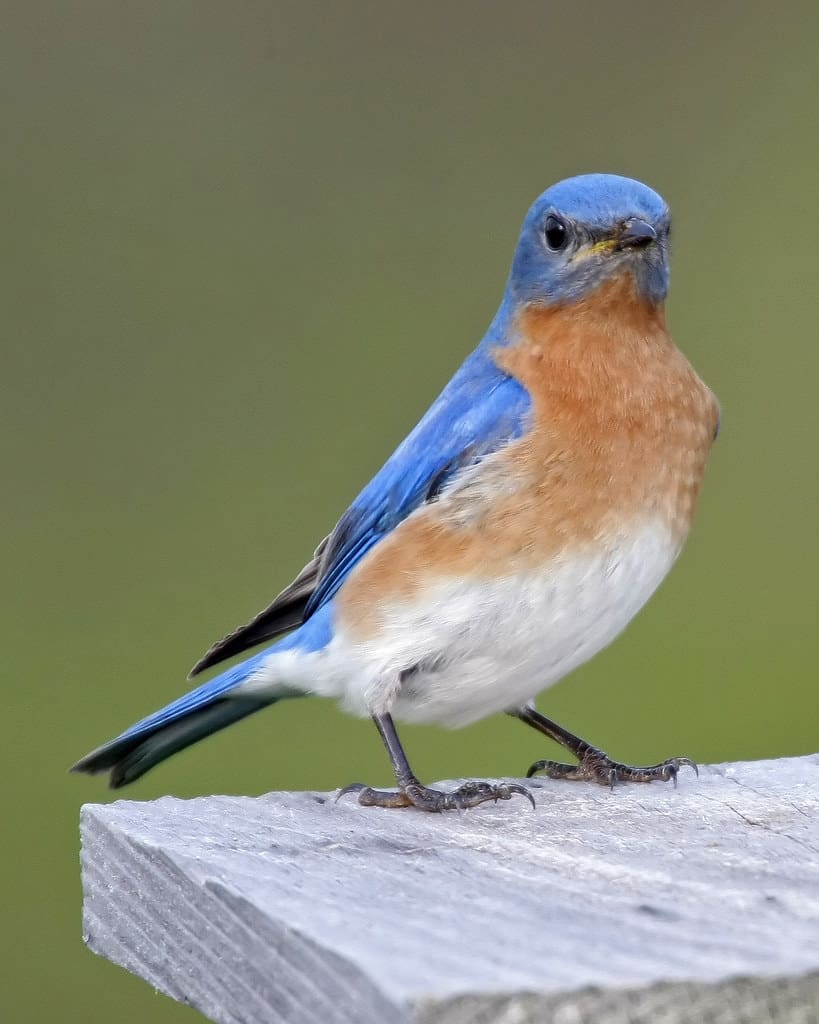
Eastern Bluebird 
Western Bluebird 
Mountain Bluebird
Left photo credit: ibm4381, licensed under CC BY 2.0
Middle photo credit: Lhallwildlife, licensed under CC BY-NC-SA 2.0
Right photo credit: USFWS Mountain Prairie is licensed under CC BY 2.0
That’s my short answer for how you can visibly distinguish the differences between Eastern, Western, and Mountain Bluebirds. In the rest of this article, I’ll show examples of each of the different species of bluebirds, with photos of males, females, and juvenile bluebirds. I’ll also explain where you can find each type of bluebirds and what other characteristics make them unique from the other species.
Let’s start with the most common, and most-studied, species of bluebird in North America: the Eastern Bluebird.
Eastern Bluebirds

Eastern Bluebirds are a small songbird in the thrush family, distantly related to another common thrush, the American Robin. The species goes by the Latin name Sialia sialis, but bluebird experts sometimes just abbreviate their name to “EABL.”
Eastern Bluebirds mostly inhabit the eastern half of the USA and Canada, east of the Rocky Mountains. And their range extends as far south as the Caribbean.
The map below shows Eastern Bluebirds’ year-round range in green, breeding range in yellow, and wintering range in blue.

Let’s take a look specifically at the male Eastern Bluebird.
The Male Eastern Bluebird
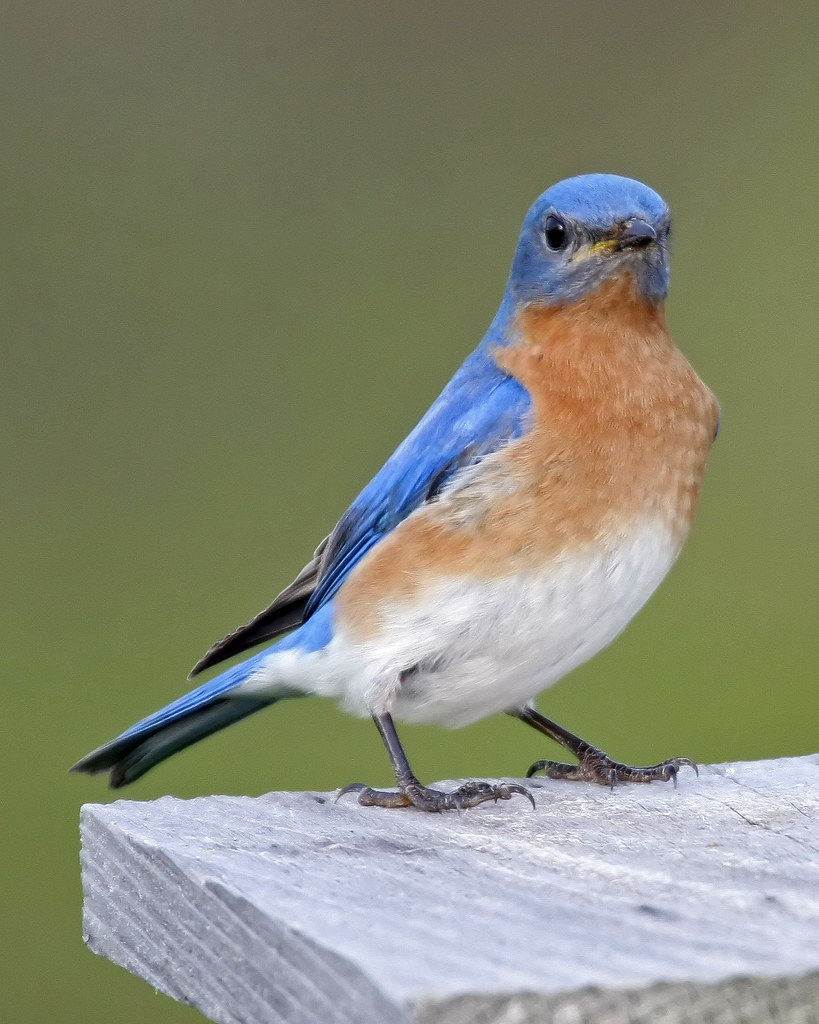
The male Eastern Bluebird has a royal blue head and back, a reddish-brown chest and throat, and a white belly. These are the main features that distinguish him from other species of bluebirds. With the other species, you will see blue and red on different areas of the body.
If you are driving through the eastern half of the United States in the summer, look out for a flash of iridescent-blue swooping off of a fence post or a telephone wire. These are common spots to see Eastern Bluebirds hunting for food and the males are the most recognizable from a distance.
The Female Eastern Bluebird
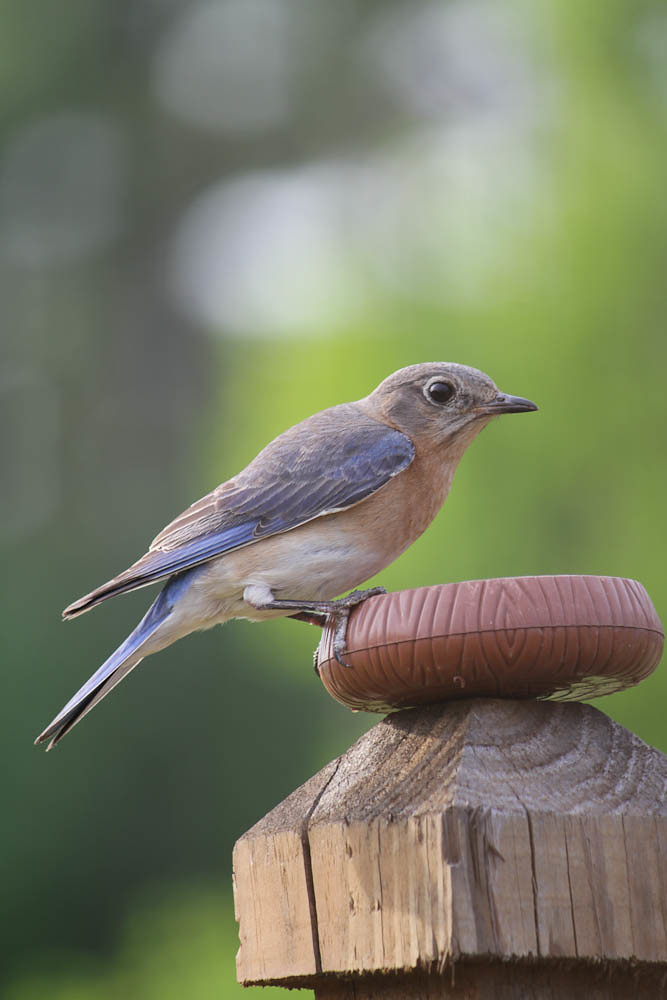
The female Eastern Bluebird looks extremely similar to the male. She has a blue back and head, reddish-brown chest and throat, and a white belly. However, as is typical with many birds, the female is duller in color and her blues and reds are a little more muted.
Even though the female looks much less blue when she’s next to a male, when I see females on their own, I’m often surprised at how brilliantly blue they are.
Juvenile Eastern Bluebirds
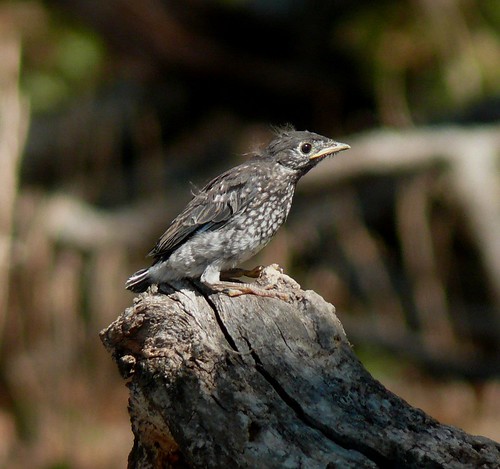
Like most bird species, Eastern Bluebird fledglings are not the prettiest to look at. While they are still juvenile, the young birds haven’t fully grown their blue wings yet, and they are speckled with white and black plumage.
Juveniles also appear a little awkward and gangly as they are getting used to walking, flying, and catching food outside of the nest box.
Fledglings will take a few weeks to stay under cover in trees and shrubs while their parents bring them food and teach them to hunt. Then, after they reach about 30 days old, they start fending for themselves (source).
What’s Unique About Eastern Bluebirds?
People usually think that Eastern Bluebirds are the smallest of the three bluebirds because they require a smaller entrance hole and a smaller nest box. While they do have the shortest wingspan of the three species (only up to 12.6 inches) they actually weigh the most on average of the three types of bluebirds (up to 32 grams for an adult).
It’s because of their shorter wingspan that Eastern Bluebirds can fit into a slightly smaller entrance hole. Experts usually recommend a 1 1/2″ round hole for Eastern Bluebirds but a 1 9/16″ round hole for other species. To read more about the proper entrance hole sizes for bluebird houses, click here to read my other article.
Western Bluebirds

The Western Bluebird is a small North American thrush, closely related to the other two species of bluebirds. The species goes by the Latin name Sialia mexicana, but experts sometimes shorten the name to “WEBL” to refer to Western Bluebirds.
Western Bluebirds live in the western half of the US, typically west of the Rocky Mountains. Their range reaches as far north as Canada and as far south as Mexico.
The map below shows Western Bluebirds’ year-round range in green, breeding range in yellow, and wintering range in blue.

Now, let’s look specifically at the male Western Bluebird.
The Male Western Bluebird

The male Western Bluebird looks very similar to a male Eastern Bluebird. The main difference is that the male Western Bluebird has a patch of blue covering its throat and reddish-brown going back to its wings.
This is the best way to distinguish a Western Bluebird from an Eastern Bluebird. If you see a blue throat, it’s a Western Bluebird, and if you see a reddish-brown throat, it’s an Eastern Bluebird.
While bluebird males are usually bright blue, the females are usually a little bit more muted in color. Let’s take a look at a female Western Bluebird.
The Female Western Bluebird

Female Western Bluebirds look very similar to their male counterparts. The only difference is that their blue and red colors are duller.
The female Western Bluebird (as seen in the photo above) has a dull blue head and back, a reddish-brown chest, and a white patch on her belly. While the male Western Bluebird has blue around his throat, the female Western Bluebird’s throat is almost gray in color.
Now, let’s take a look at fledgling (or juvenile) Western Bluebirds. This is what a Western Bluebird will look like right after it leaves the nest.
Juvenile Western Bluebirds
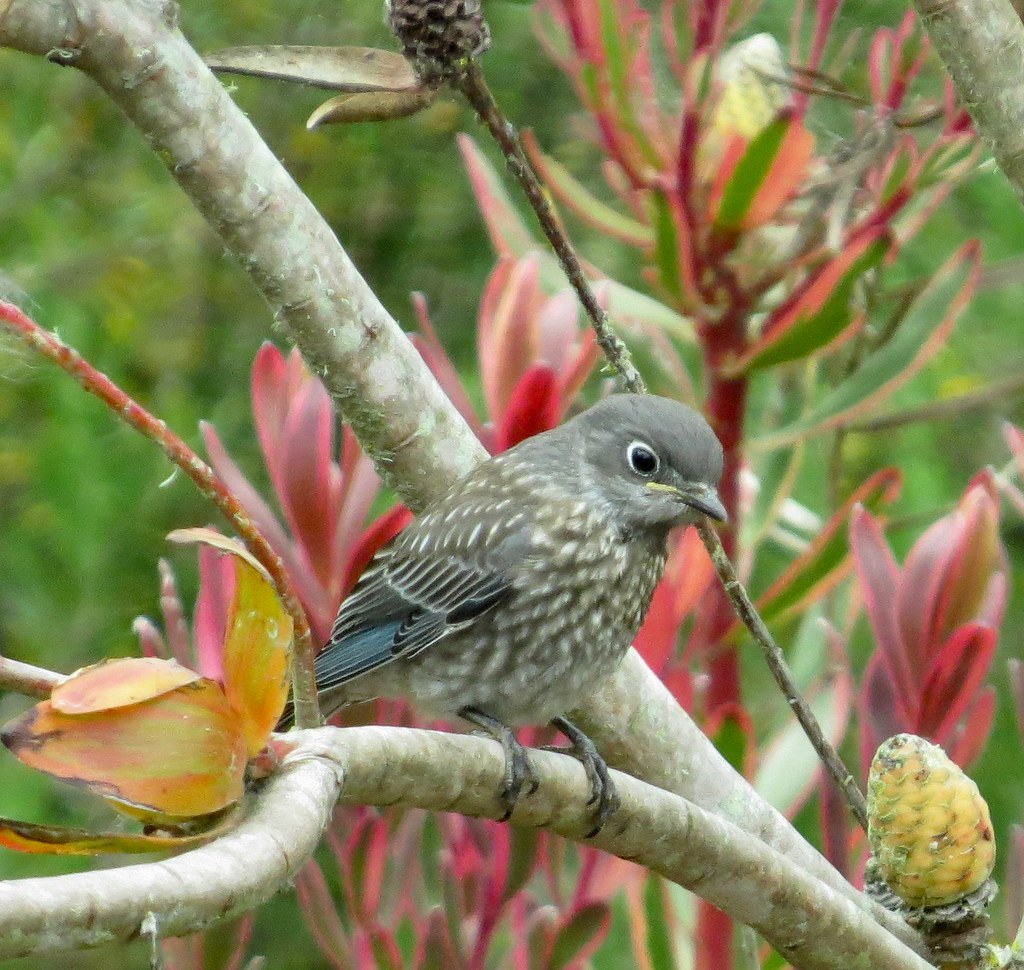
Western Bluebird juveniles look very similarly to other young bluebirds after they leave the nest. They are dull gray in color and have white spots covering their bodies.
Bright blue wings will start to develop in juvenile bluebirds over time. Sometimes you’ll even be able to see blue-tipped wings on male Western bluebirds before they leave the nest.
What’s Unique About Western Bluebirds?
Western Bluebirds hang out around woodlands more often than their Eastern counterparts. While Eastern Bluebirds prefer open fields and prairieland, Western Bluebirds can usually be found “on low perches in woodlands and woodland edges,” according to the Cornell Lab of Ornithology (source). It’s interesting how these two species of bluebirds have learned to adapt to different environments.
Now, for the last species of bluebirds – Mountain Bluebirds.
Mountain Bluebirds
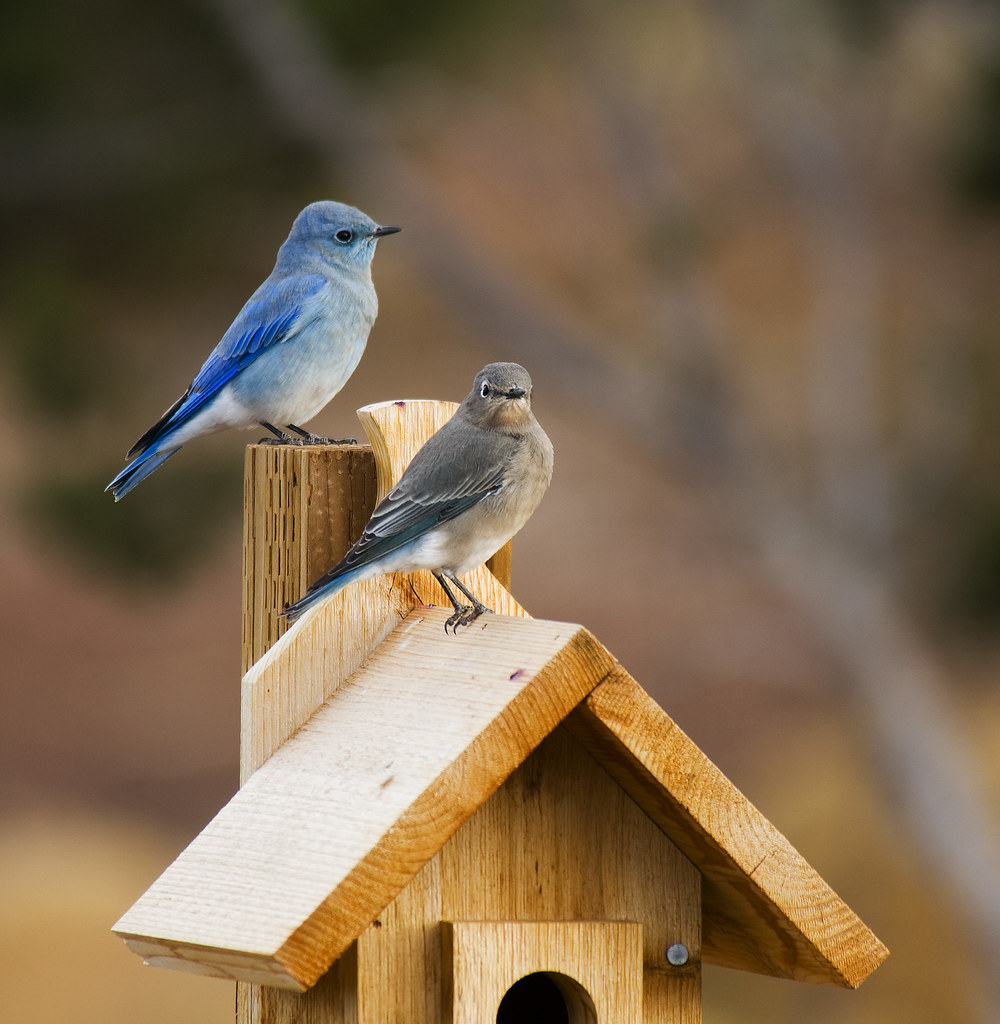
Mountain Bluebirds are a small North American songbird in the thrush family, closely related to Eastern and Western Bluebirds. The Latin name for Western Bluebirds is Sialia currucoides, but experts and researchers often refer to them by the abbreviation “MOBL.”
The Mountain Bluebird species is mostly found west of the Rocky Mountains in the USA and Canada. Plus, as their name might suggest, they typically live in areas at a higher elevation.
The map below shows Mountain Bluebirds’ year-round range in green, breeding range in yellow, and wintering range in blue.

You’ll see from the map above that Mountain Bluebirds travel the farthest north of any bluebird species. They can be found from Alaska all the way down to New Mexico during the breeding season and year-round. Then they travel as far south as Mexico during the winter.
The Mountain Bluebirds has different physical characteristics than the other species of bluebirds. Let’s take a look at the male Mountain Bluebird.
The Male Mountain Bluebird
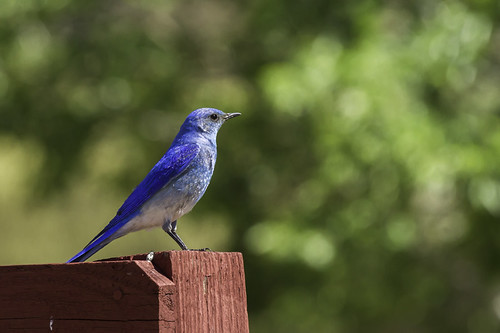
The male Mountain Bluebird is the bluest of any type of bluebird. He has royal blue covering his head, back, throat, and chest, with a patch of white under his lower belly.
Since they are clearly an “all blue” bluebird, male mountain bluebirds are fairly easy to distinguish from the other species. When looking to spot the difference between Eastern, Western, and Mountain Bluebirds, look for an all blue bird and you’ll know it’s a Mountain Bluebird.
The Female Mountain Bluebird
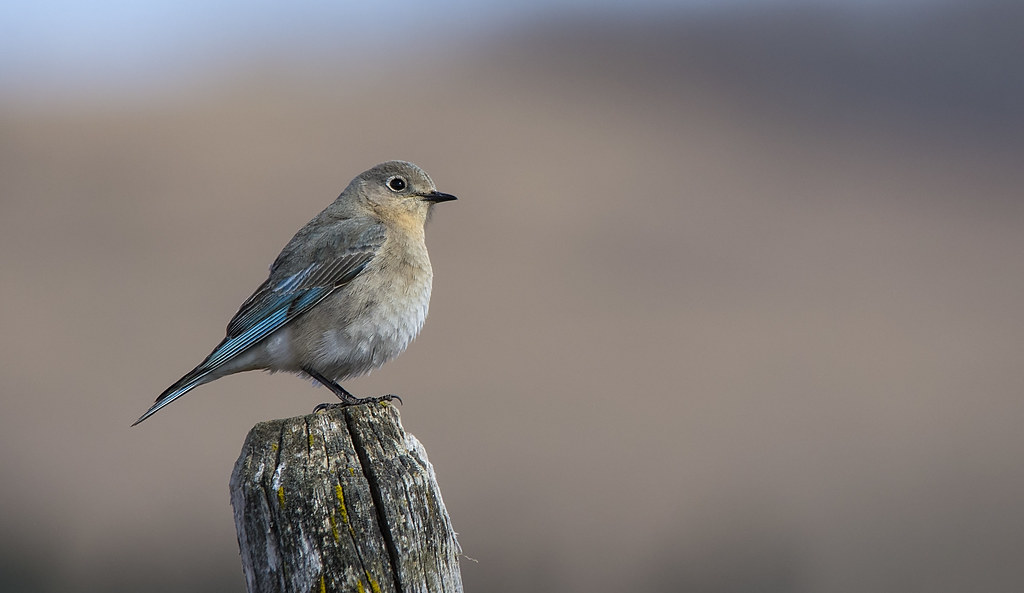
It’s a little more challenging to tell the difference between a female Mountain Bluebird and females of the other two species.
Female Mountain Bluebirds have dull blue on their head and back, and they have a white patch on their belly. But their chest varies in color from gray to reddish-brown throughout the year. This fact can make them appear very similar to Eastern Bluebirds.
Notice in the photos how the female Mountain Bluebird on the left is almost indistinguishable from the female Eastern Bluebird on the right.
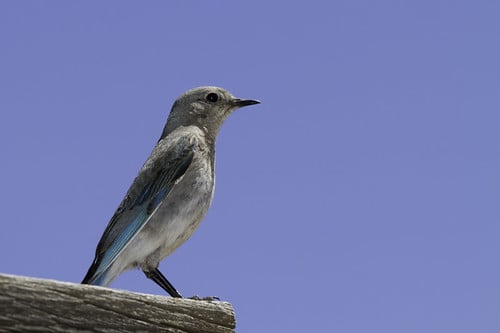
Female Mountain Bluebird 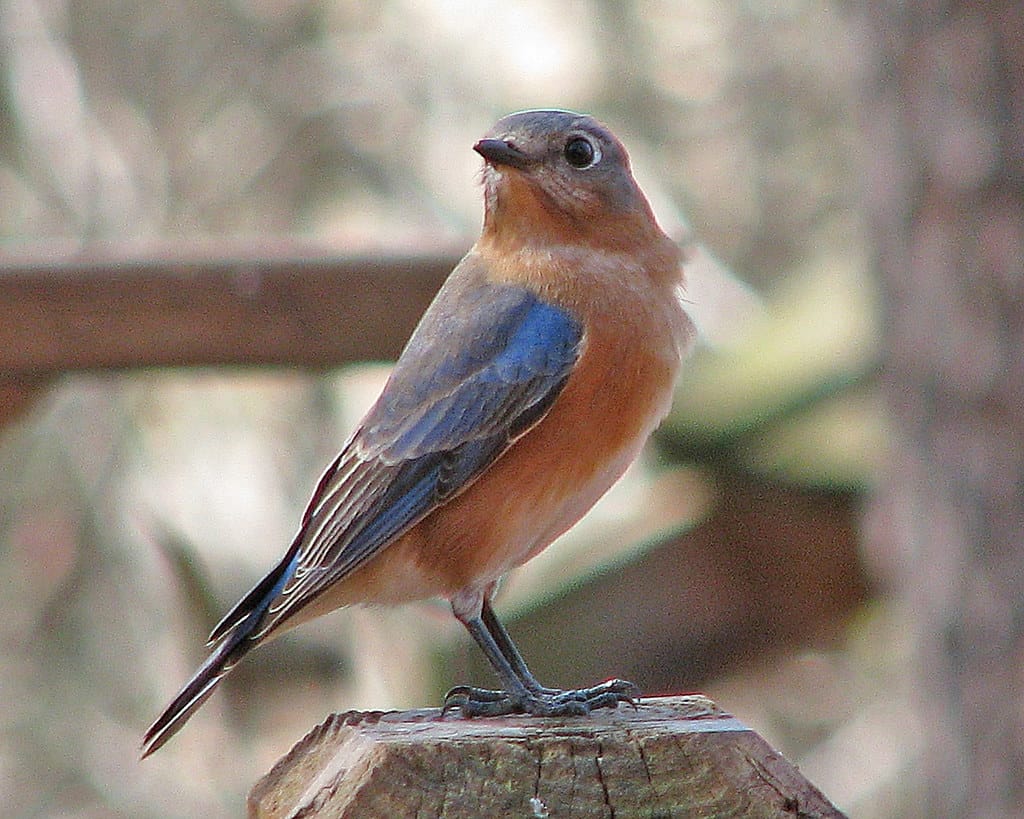
Female Eastern Bluebird
Photo credit left: Alan Vernon, licensed under CC BY-NC-SA 2.0
Photo credit right: Vicki’s Nature, licensed under CC BY-NC-ND 2.0
If you’re ever in a situation where you think you’ve spotted a female Mountain Bluebird and a female Eastern Bluebird at the same time, a good way to tell the difference is looking for how bright or dull the reddish-brown plumage is. Mountain Bluebirds will be slightly duller in appearance.
Juvenile Mountain Bluebirds
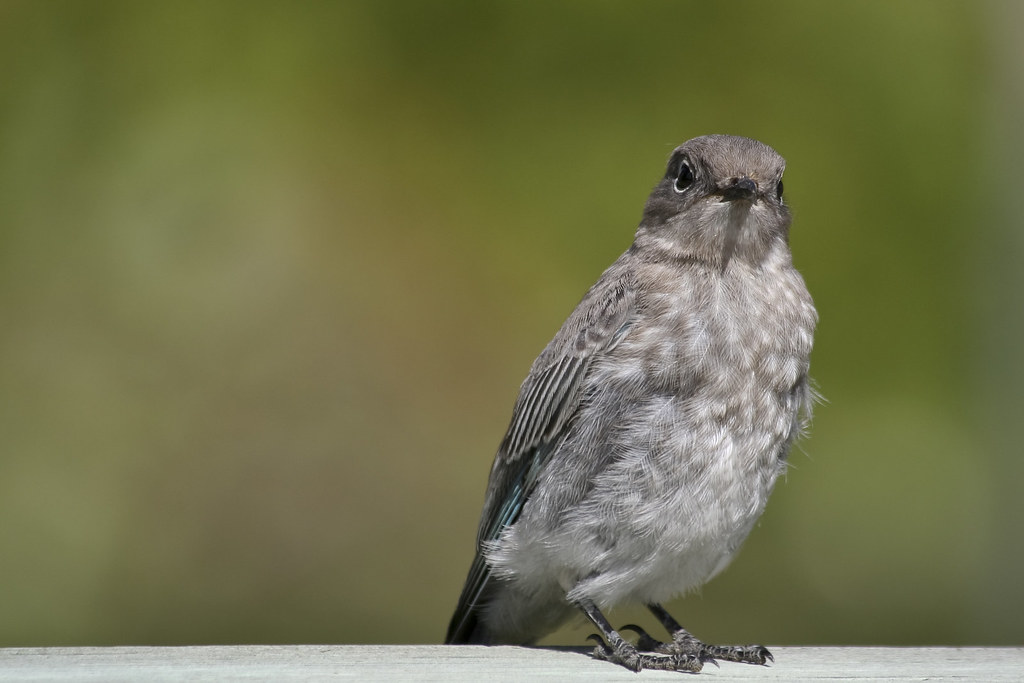
Juvenile Mountain Bluebirds look very similarly to other fledgling bluebirds. They’re dull gray, haven’t quite grown in their blue feathers yet, and they are speckled with white dots all over their body.
As with the other species of bluebirds, male juveniles will start showing bright blue on the tips of their wings earlier than females, sometimes even while they’re still in the nest.
If you see fledglings being taken care of by their parents, they’re probably still 30 days old or younger. Though they might hang out with their parents longer than that to help out with their next nest.
What’s Unique About Western Bluebirds?
While Eastern and Western Bluebirds usually swoop down and land on the ground to catch their prey, Mountain Bluebirds love to hover! From time to time, they will hover in mid-air, flapping their large wings like a Kestrel, and catch insects mid-flight. Since doing this expends more energy than just landing straight on the ground, they apparently only do it when insects are more scarce (source).
Also, since Mountain Bluebirds have the largest wingspan of the bluebird species (up to 14.2 inches) they prefer to have a larger entrance hole on their nest box than other bluebirds. Experts recommend putting a round entrance hole of 1 9/16 inches on nest boxes designed for Mountain Bluebirds. You can read more about the proper entrance hole sizes for bluebirds in this article I wrote here.
Conclusion
I hope this article has helped you understand the differences between Eastern, Western, and Mountain Bluebirds. Essentially, all three species are cut from the same cloth physically, it’s just a matter of how much reddish-brown or royal blue they have on their bodies. No matter which species of bluebird lives near you, you should definitely consider attracting these birds to your yard!
If you want to get started attracting bluebirds to your own backyard, click here to check out my article called 10 Steps to Become a Bluebird Landlord. This article will tell you everything you need to know to get started.
Also, you can check out my Recommended Tools page here to see the bluebird nest boxes, feeders, and other tools that I use myself.

